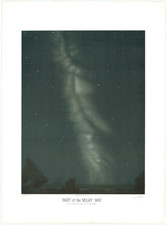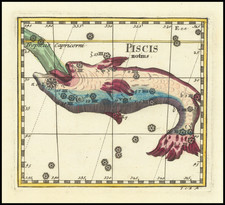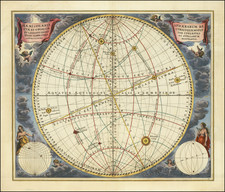This finely detailed 19th-century French map, entitled "Cosmographie Générale," presents a comprehensive visual synthesis of contemporary celestial knowledge. The image meticulously displays various heliocentric models, elucidating the orbital mechanics of the planets and their moons, the terrestrial phenomena of seasons, solar and lunar eclipses, as well as the lunar phases, with each astronomical concept thoughtfully placed within its own quadrant surrounding the central diagram.
The historical context of this map is deeply rooted in the rich tradition of French scientific enlightenment. During the 19th century, France was at the forefront of celestial cartography, striving to depict the cosmos with both scientific accuracy and aesthetic finesse. This map is a testament to the era's educational endeavors and public fascination with the heavens, reflecting the period's advancements in observational astronomy and the widespread acceptance of heliocentrism.
The central diagram dominates the map, illustrating the Solar System with the Sun at its heart, an arrangement that echoes the Copernican revolution and the subsequent work by Kepler and Newton. It is a visual representation of the enlightened scientific worldview, showcasing the intricate dance of celestial bodies in elliptical orbits, a concept that had only been quantified a few centuries prior.
Surrounding the central depiction are supplemental diagrams. The theory of the seasons is elucidated, showing the Earth's axial tilt and orbit around the Sun, providing a clear explanation for the changing seasons. Adjacent, the mechanics of solar and lunar eclipses are detailed, depicting the interplay of shadows between the Sun, Earth, and Moon. Additionally, the meticulously rendered phases of the Moon offer insights into the monthly transformation of our celestial companion as observed from Earth.
This map serves not only as a visual archive of scientific understanding from the era but also as an educational tool. Its intricate detail and precise labeling speak to its purpose as an instrument of dissemination for the astronomical knowledge of the time. The map is a confluence of science, education, and art, reflective of a period when the mysteries of the cosmos were being unraveled with ever-increasing clarity and shared with a curious public eager to comprehend the universe's grandeur.











![[The First Maps Printed Color] Cartes en Couleur des Lieux Sujets aux tremblements de Terre Dans toutes les parties du Monde Selon le Sisteme de l’impulsion Solaire](https://storage.googleapis.com/raremaps/img/small/52293op.jpg)


![[Six Star Charts] The Stars, in Six Maps, on the Gnomonic Projection, revised by the Rev. W.R. Dawes. . .](https://storage.googleapis.com/raremaps/img/small/78480.jpg)